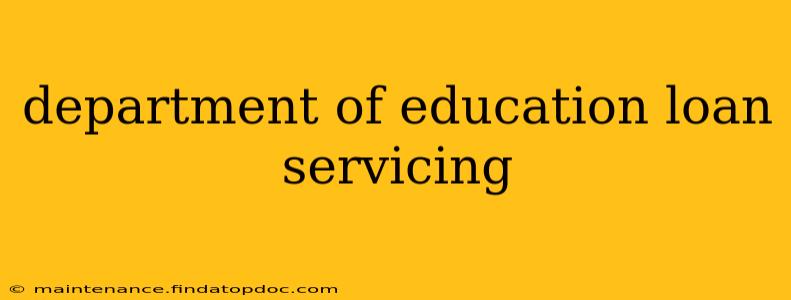Navigating the complexities of federal student loan repayment can feel overwhelming. Understanding who services your loans and what their role entails is crucial for successful repayment and avoiding potential pitfalls. This guide will delve into the Department of Education's loan servicing process, answering common questions and providing valuable insights for borrowers.
What is the Department of Education's role in loan servicing?
The U.S. Department of Education (ED) doesn't directly service federal student loans itself. Instead, it contracts with various loan servicers – private companies – to manage the day-to-day tasks associated with student loan repayment. These servicers handle communication with borrowers, process payments, answer questions, and manage repayment plans. The ED, however, oversees these servicers, ensuring they adhere to federal regulations and protect borrowers' rights. They set the overall policies and guidelines that servicers must follow.
Who is my student loan servicer?
Determining your loan servicer is the first step in managing your student loans effectively. You can find this information through several methods:
- Your loan documents: Your original loan documents should clearly state your servicer's name and contact information.
- The National Student Loan Data System (NSLDS): NSLDS is a U.S. Department of Education website that provides a centralized view of your federal student aid. Accessing your NSLDS account will reveal your current loan servicer.
- Your loan servicer's website: If you have a general idea of which company services your loans, checking their website and using their online tools is another way to confirm.
- Contacting the Federal Student Aid Information Center: If you're having trouble finding your servicer, contacting the Federal Student Aid Information Center is a reliable option.
It's crucial to keep your contact information updated with your servicer to ensure timely communication regarding your loans.
How do I contact my student loan servicer?
Each loan servicer offers multiple ways to contact them, typically including:
- Phone: A dedicated phone number for customer service is usually readily available on their website.
- Mail: A physical mailing address will be listed on your statements and their website.
- Online account access: Most servicers have secure online portals where you can view your loan details, make payments, and communicate with customer service.
- Email: While not always the primary method, many servicers provide email addresses for inquiries.
What happens if my student loan servicer changes?
The Department of Education sometimes transitions loan servicing contracts to different companies. If this happens, you'll receive official notification from both your current and new servicer. This notification will explain the change, provide your new servicer's contact information, and outline any actions you need to take. It's essential to carefully review this information to avoid any disruptions in your repayment plan.
What services do student loan servicers provide?
Student loan servicers offer a wide array of services, including:
- Payment processing: Handling payments made through various methods like online, mail, or phone.
- Account management: Providing access to online accounts to view loan details, repayment schedules, and payment history.
- Repayment plan options: Explaining and helping borrowers choose the most suitable repayment plan based on their financial situation.
- Deferment and forbearance: Assisting borrowers in applying for temporary pauses in payments under specific circumstances.
- Loan consolidation: Helping borrowers combine multiple federal student loans into a single loan with a simplified repayment process.
- Customer support: Answering questions and providing guidance on all aspects of loan repayment.
What if I'm having trouble making my student loan payments?
Falling behind on your student loan payments can have serious consequences. If you're experiencing financial hardship, contact your loan servicer immediately. They can explore options such as:
- Income-Driven Repayment (IDR) Plans: Adjusting your monthly payment based on your income and family size.
- Deferment: Temporarily suspending your payments for a specified period.
- Forbearance: Temporarily reducing your monthly payments or suspending them altogether.
It's crucial to communicate proactively with your servicer to avoid delinquency and potential damage to your credit score.
How do I find out which repayment plan is right for me?
Choosing the right repayment plan depends on your individual financial circumstances and goals. Your loan servicer can guide you through the various options, helping you understand the pros and cons of each. Factors to consider include your income, family size, and long-term financial goals. The Federal Student Aid website also offers valuable resources to help you compare and choose a repayment plan.
This comprehensive guide provides a solid foundation for understanding the Department of Education's role in loan servicing and how to effectively manage your federal student loans. Remember, proactive communication with your servicer is key to successful repayment.
